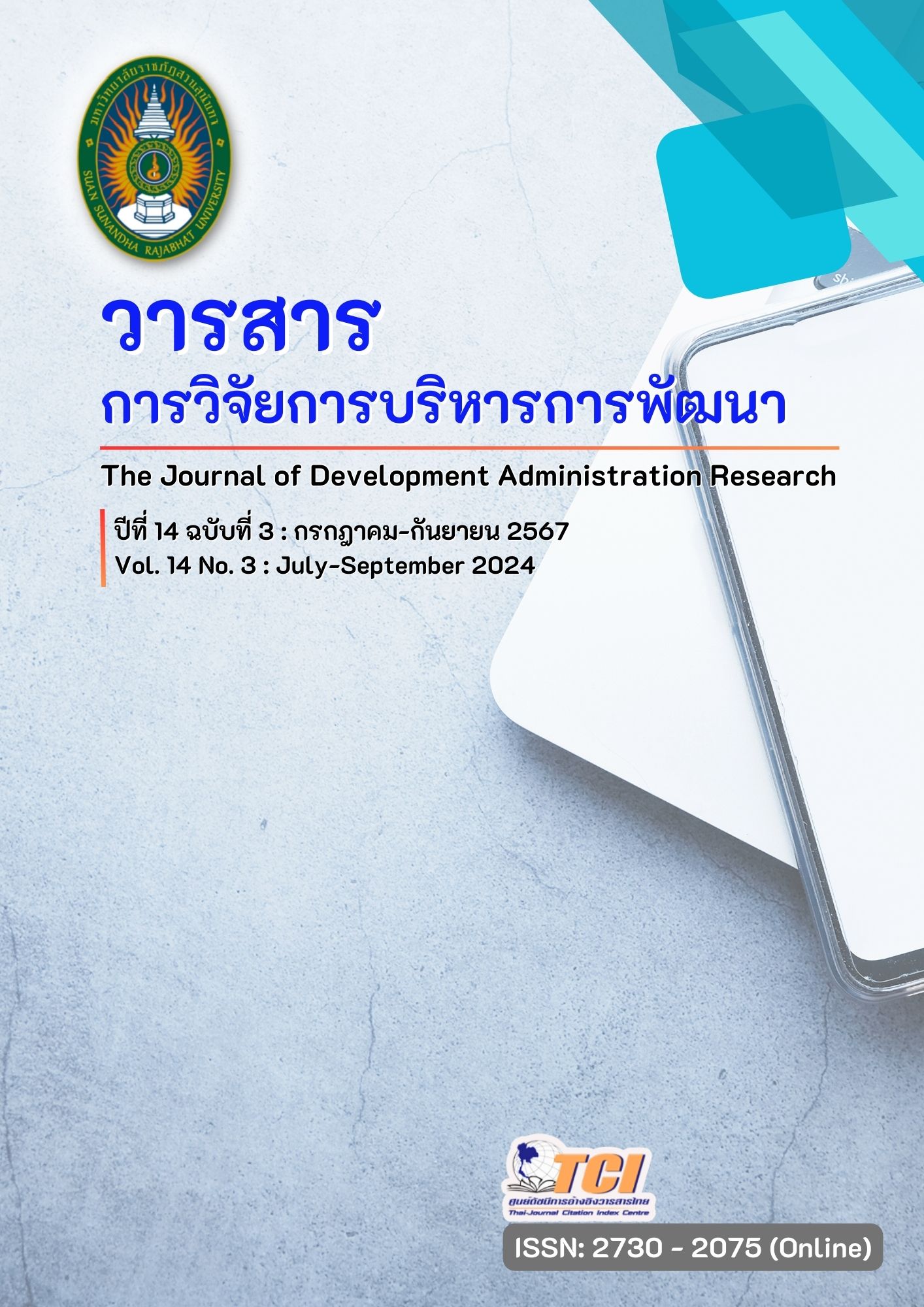The Leading of Financial Investment Awareness among Generation Z in Indonesia
คำสำคัญ:
Family Financial Socialization, Financial Attitude, Investment Awareness, Saving Behaviorบทคัดย่อ
Currently, there is more awareness of financial education and literacy to Generation Z in several countries. As Generation Z is the large group of population and plays an important role in economic development. This generation faces financial challenges and technological advancement. Therefore, creating financial investment awareness is crucial for Generation Z. However, financial investment awareness of Generation Z is affected by several factors. This research emphasized the study of the influences of financial investment awareness among Generation Z in Indonesia as Indonesia's population is dictated by Generation Z and the millennial generation. Generation Z makes up 27.94% of the total population. This generation can possibly affect the economic growth of Indonesia. The data were collected by surveying 259 respondents and analyzed by Structural Equation Modeling (SEM). The research result showed three critical variables influencing financial investment awareness of Generation Z: financial attitude, family monetary socialization, and saving behavior. All three components have positive impacts on investment awareness
เอกสารอ้างอิง
Ali, M.A.S, Ammer, M.A., & Elshaer, I.A. (2022). Determinants of Investment Awareness: A Moderating Structural Equation Modeling-Based Model in the Saudi Arabian Context. Mathematics, 10, 3829.
Allen, M. W., Edwards, R., Hayhoe, C. R., & Leach, L. (2007). Imagined interactions, family money management patterns and coalitions, and attitudes toward money and credit. Journal of Family and Economic Issues, 28, 3-22.
Anggarini, D. T. (2022). Generation Z and Millennials perspectives to become entrepreneurs in the era of GIG economy. Jurnal Ekonomi dan Manajemen, 10-26.
Amari, M., Salhi, B., & Jarboui, A. (2020). Evaluating the effects of sociodemographic characteristics and financial education on saving behavior. International Journal of Sociology and Social Policy, 40(11/12), 1423-1438.
Behavior in Bekasi Regency). Economic Education Analysis Journal, 12(1), 69-79.
Bentler, P. M., & Bonett, D. G. (1980). Significance tests and goodness-of-fit in the analysis of covariance structures. Psychological Bulletin, 88(3), 588–606.
Bentler, P. M. (1990). Comparative fit indexes in structural models. Psychological Bulletin, 107(2), 238–246.
Bollen, K. A. (1989). Structural equations with latent variables. New York: John Wiley & Sons.
Browne, M. W., & Cudeck, R. (1992). Alternative ways of assessing model fit. Sociological Methods & Research, 21(2), 230-258.
Bucciol, A., Manfrè, M., & Veronesi, M. (2022). Family financial socialization and wealth decisions. The BE Journal of Economic Analysis & Policy, 22(2), 281-309.
Byrne, B. M. (2012). Structural Equation Modeling with Mplus: Basic Concepts, Applications, and Programming. New York: Routledge.
Camerer, C. F., Loewenstein, G., & Rabin, M. (Eds.). (2004). Advances in behavioral economics. Princeton, NJ: Princeton University Press.
Chalimah, S. N., Martono, S., & Khafid, M. (2019). The saving behavior of public vocational high school students of business and management program in Semarang. Journal of Economic Education, 8(1), 22-29.
East, R., Romaniuk, J., Chawdhary, R., & Uncles, M. (2017). The impact of word of mouth on intention to purchase currently used and other brands. International Journal of Market Research, 59(3), 321-334.
Foster, L., Heneghan, M., & Wijeratne, D. (2019). Women millennials’ perceptions of pension savings through the use of autoenrollment in the UK pension system. Journal of Women & Aging, 31(4), 340-360.
Gawel, A. (2023, April 4). “Will Gen X, Millennials, and Gen Z shake up philanthropy?” Indonesia Financial Services Authority (OJK). https://www.devex.com/news/devex-newswire-will-gen-x-millennials-and-gen-z-shake-up-philanthropy-105261
Gerhard, P., Gladstone, J. J., & Hoffmann, A. O. (2018). Psychological characteristics and household savings behavior: The importance of accounting for latent heterogeneity. Journal of Economic Behavior & Organization, 148, 66-82.
Gudmunson, C. G., & Danes, S. M. (2011). Family financial socialization: Theory and critical review. Journal of family and economic issues, 32, 644-667.
Hair, J. F., Black, W. C., Babin, B. J., & Anderson, R. E. (2014). Multivariate Data Analysis (7thed.). Pearson.
Hassan, M. K., & Lawrence, S. (2007). Financial preparation for retirement: factors affecting retirement preparation through employer sponsored retirement plans. Indiana: Indiana State University, Networks Financial Institute, 2007-WP-09, 2007a.
Hidayat, C. M., & Muntahanah, S. (2024). The investment decision on generation Z in the Capital Market. Journal of Management Science (JMAS), 7(1), 8-14.
Inseng, H. D. (2019). Symbolic Money Attitudes and Compulsive Buying: are they all bad for Happiness?. African Journal of Business & Economic Research, 14(1), 31-48
Kaiser, H. F. (1974). An index of factorial simplicity. Psychometrika, 39(1), 31-36.
Kim, J., LaTaillade, J., & Kim, H. (2011). Family processes and adolescents’ financial behaviors. Journal of family and economic issues, 32, 668-679.
Kim, W. G., Li, J., Han, J. S., & Kim, Y. (2017). The influence of recent hotel amenities and green practices on guests’ price premium and revisit intention. Tourism economics, 23(3), 577-593.
Kline, R. B. (2015). Principles and practice of structural equation modeling. New York: Guilford Press.
Kochhar, K. (2024). Family Financial Socialization: Impact of Scholarship Payments on Research Scholars’ Financial Behaviour and Financial Well-Being. Indian Journal of Finance, 18(3), 56-67.
Lestari, D. (2019). Measuring e-commerce adoption behaviour among gen-Z in Jakarta, Indonesia. Economic Analysis and Policy, 64, 103-115.
Nadlifatin, R., et al. (2022). Social media-based online entrepreneurship approach on millennials: A measurement of job pursuit intention on multi-level marketing. Procedia Computer Science, 197, 110-117.
Pankow, D. (2012). Financial Values, Attitudes and Goals. Family Economic Specialist, NDSU.
Prasetyo, F. A., & Mustaqim, M. (2024). Financial technology, financial knowledge, and financial attitude of Generation Z: Determinants of financial behavior. Journal of Enterprise and Development (JED), 6(2), 335-344.
Shanmugham, R., & Ramya, K. (2012). Impact of social factors on individual investors’ trading behavior. Procedia Economics and Finance, 2, 237-246.
Steiger, J. H. (1990). Structural model evaluation and modification: An interval estimation approach. Multivariate Behavioral Research, 25(2), 173-180.
Trivani, G., & Soleha, E. (2023). The Effect of Financial Literacy, Income and Self Control on Financial Behavior Generation Z (Study on Generation Z Financial). Economic Education Analysis, 2(1), 69-79.
Tucker, L. R., & Lewis, C. (1973). A reliability coefficient for maximum likelihood factor analysis. Psychometrika, 38(1), 1–10.
ดาวน์โหลด
เผยแพร่แล้ว
รูปแบบการอ้างอิง
ฉบับ
ประเภทบทความ
สัญญาอนุญาต
ลิขสิทธิ์ (c) 2024 วารสารการวิจัยการบริหารการพัฒนา

อนุญาตภายใต้เงื่อนไข Creative Commons Attribution-NonCommercial-NoDerivatives 4.0 International License.
บทความที่ได้รับการตีพิมพ์เป็นลิขสิทธิ์ของมหาวิทยาลัยราชภัฏสวนสุนันทา
ข้อความที่ปรากฏในบทความแต่ละเรื่องในวารสารวิชาการเล่มนี้เป็นความคิดเห็นส่วนตัวของผู้เขียนแต่ละท่านไม่เกี่ยวข้องกับมหาวิทยาลัยราชภัฏสวนสุนันทา และคณาจารย์ท่านอื่นๆ ในมหาวิทยาลัยฯ แต่อย่างใด ความรับผิดชอบองค์ประกอบทั้งหมดของบทความแต่ละเรื่องเป็นของผู้เขียนแต่ละท่าน หากมีความผิดพลาดใดๆ ผู้เขียนแต่ละท่านจะรับผิดชอบบทความของตนเองแต่ผู้เดียว




